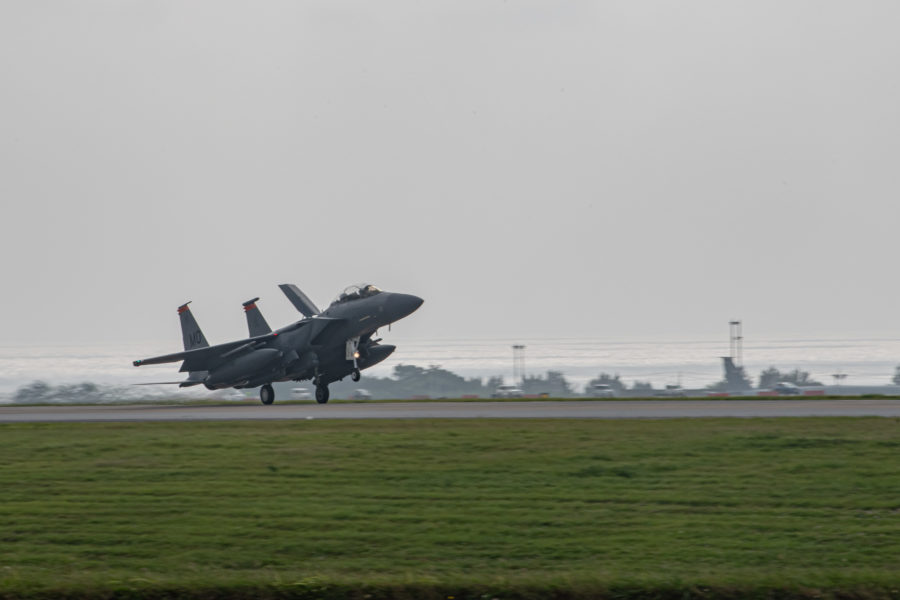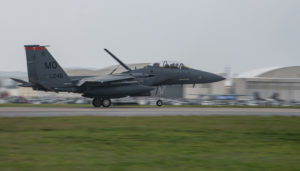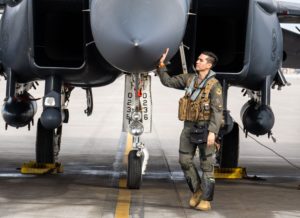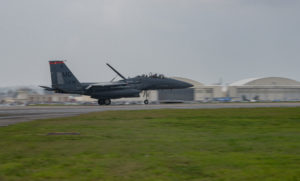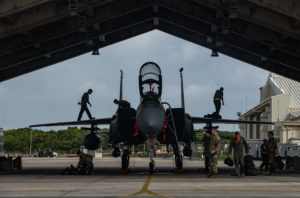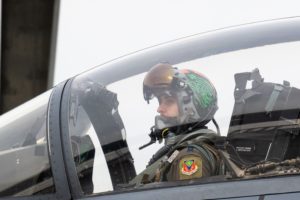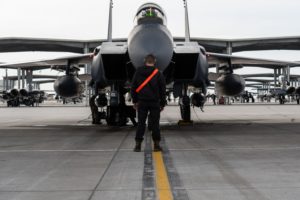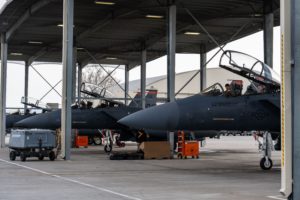The Air Force’s overhaul of Kadena Air Base, Japan, took yet another step with the arrival of more F-15E Strike Eagles to replace the aging F-15C/Ds at the base. According to a service spokesperson, the Air Force plans to send all F-15Cs at Kadena back to the U.S. by September, replaced by rotational forces of newer aircraft as part of plans first announced in October 2022.
On April 22, F-15Es from the 391st Fighter Squadron at Mountain Home Air Force Base, Idaho landed at Kadena, the Air Force said. According to a news release from Kadena’s 18th Wing, the aircraft will operate alongside F-15Es that arrived earlier this month from Seymour Johnson Air Force Base, N.C., as well as fifth-generation F-35 Lightning IIs from Eielson Air Force Base, Alaska that arrived in late March.
The Air Force has sent 18 F-15Cs back to the continental United States from Kadena since the service announced plans to wind down operations there, according to Air Force spokeswoman Ann Stefanek. Four of those aircraft have been retired, she added. Before the drawdown, Kadena had around 48 permanently based Eagles in two squadrons.
“The Air Force plans to divest the remaining F-15Cs from Kadena in FY23,” Stefanek said, referring to fiscal 2023, which ends in September. It was not immediately clear if the same timeline applied to the remaining two-seat F-15D models at the base, one of which the head of Pacific Air Forces, Gen. Kenneth S. Wilsbach, recently flew in.
Lt. Gen. Richard G. Moore, Jr., deputy chief of staff for plans and programs, told the House Armed Services Committee in March that of Kadena’s Eagles, there are “three that are grounded forever and four that can only that are only capable of one-time flight to the Boneyard.” The Air Force previously said the Eagles from Kadena would either be retired or enter Air National Guard service. Kadena’s Eagle operations date back to the late 1970s.
As for the recently arrived Strike Eagles, a spokesperson for Mountain Home said the base sent aircraft and Airmen from the 391st Fighter Squadron along with Airmen from its associated maintenance support group, the 391st Fighter Generation Squadron. The spokesperson did not say how many aircraft deployed. The Air Force has previously declined to specify exactly how many jets are deploying to Kadena under each rotation, citing operational security.
“As the 18th Wing continues the phased return of Kadena’s fleet of Eagles, the Department of Defense will maintain a steady-state fighter presence in the region by temporarily deploying newer and more advanced aircraft to backfill the F-15s as they retrograde,” Kadena said in its release.
The F-15Es and F-35s replaced F-22 Raptors from Joint Base Elmendorf-Richardson, Alaska and F-16 Fighting Falcons from Spangdahlem Air Force Base, Germany, the first two sets of aircraft to begin the rotational presence at Kadena in place of permanent squadrons.
The Air Force is removing Kadena’s F-15C/D Eagles, the last of the type on the Active-Duty fleet, due to their age and airworthiness. Long-term plans for the base have yet to be announced.
“Between our permanent party Airmen and our deployed forces, we are well postured to deter, deny, and if necessary, defeat any threat to regional stability and the U.S. homeland,” said 18th Wing commander Brig. Gen. David S. Eaglin. “The robust combat capability here on the Kadena flightline serves as a powerful deterrent to potential adversaries and offers unique integration opportunities with our allies and partners.”
Kadena, on the southern Japanese island of Okinawa, is an important strategic location for the U.S. military, lying some 450 miles from the possible flashpoint of Taiwan, the self-governing island that the Chinese government claims. The top U.S. commander for the Indo-Pacific said recently he does not favor reducing the number of aircraft deployed within the so-called First Island Chain, a strip of islands in the western Pacific close to the Asian mainland, including China, America’s “pacing challenge.”
“As we align and execute the National Defense Strategy, the positioning of those forces certainly would be beneficial to be maintained,” Adm. John C. Aquilino, the head of U.S. Indo-Pacific Command (INDOPACOM), told the House Armed Services Committee on April 18 said when asked about the Air Force’s presence in the Pacific. “Inside of the first island chain … I have supported those forces to remain in place and/or be replaced by equivalent capability and numbers.”
